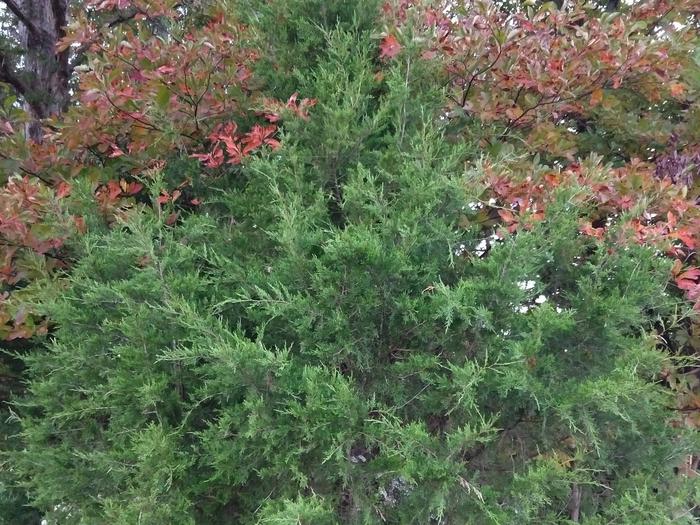Seasonal Tree Permit
Shawnee National Forest Christmas Tree Permit
This permit allows you to cut a Christmas Tree within designated areas of the Shawnee National Forest! Lifelong memories are built during these special times, and we are happy to help with any information gathering you'll need to make this trip a safe and enjoyable one.
It can be hard to find the "perfect" tree...We recommend a preliminary scouting trip to identify an area with a good selection of redcedar trees before you are ready to head into the woods with your saw.
Please be sure to read and agree to all the tips and guidelines when selecting your tree.
Fees and Season Dates
Need to Know
Where to Cut Your Tree
Do not cut trees on private land. Permit holder is responsible for ensuring they are cutting the tree on U.S. Forest Service – Shawnee National Forest land and within an appropriate area.
Within the Shawnee National Forest, do not cut trees in Wilderness areas, Natural Areas, or experimental forests.
Do not cut within active timber sales or areas that have been planted with new trees.
Do not cut trees in developed recreation areas (e.g., campgrounds, picnic areas, interpretive areas, observation sites, or trailheads) or within a 150 yard buffer surrounding the recreation site. This limitation also applies to National Register Sites (Saline Springs and Millstone Bluff) and along the Trail of Tears National Historic Trail.
Do not cut trees within 150 feet of water bodies or in any area of the Forest closed under a Forest Order.
Christmas trees may be cut along roads and trails, other than those locations restricted above. Consider safety, and remove all debris from the road or trail. Shawnee National Forest motor vehicle restrictions must be followed when removing and hauling the Christmas tree.
The maps on the permit website will help you find roads near or adjacent to national forest land. They also show the restricted (no-cut) areas of the Forest.
Pre-scouting for a tree is recommended. If you don't have the chance to pre-scout, be sure to allow enough time to find, cut, and remove your Christmas tree. Finding the perfect tree may take a few hours.
Selecting Your Tree
Each forest has limitations on the size of the tree you can cut and the species of trees that are permitted. See below to help you measure and choose a tree that meets your permit's guidelines. On the Shawnee NF:
Only Eastern redcedar trees may be cut under this permit.
No tree taller than 15 feet may be cut.
Stump diameter: 6 inches maximum.
Take the whole tree. Do not just remove the top of the tree; cut down the entire tree.
The stump should be cut no more than 6" above the ground.
If snow is on the ground, remove it from around the stump so you can accurately measure the stump and tree height.
Maps
Planning Your Trip
How to Plan Your Trip
Before you leave home, be sure to measure the space where you plan to place the tree in your home (height and width), and measure the space in your vehicle where you will be transporting the tree.
You must print and bring your Christmas Tree Permit with you.
Cell service may be spotty or unavailable. Be sure someone knows where you are and when to expect you back.
Check the latest weather conditions, forest warnings and road closures before you leave on your trip. Expect and be prepared for winter weather, including cold temperatures, snow or rain, and winds.
Use one of the maps on the permit website to pick a general location on the forest to scout for your Christmas tree. Don't forget to download and/or print the map to take with you.
Identify the forest roads you want to drive in search for a tree. If you think you will have trouble locating the forest road, contact one of our offices for a Motor Vehicle Use Map. Don’t rely on GPS because it may not be up-to-date with Forest Service roads.
Be aware of road conditions and the capabilities of your vehicle. Dirt roads may become impassable in wet periods. Park in areas so that traffic can get by safely, and do not block roads or gates.
Be sure your vehicle has a full tank of gas. Bring a spare key and give it to someone else in your party. Don’t get locked out of your car!
We don't recommend bringing your pets but, if you do, they must be under control.
Helpful Cutting Tips
Chainsaws can be used in cutting the tree, but trucks, tractors, winches, ATV/UTVs, or other mechanized equipment are not allowed to be used in dragging the tree out.
Carry your tree carefully out of the woods. Dragging the tree will rub off needles and bark.
If the tree is too big to transport inside of your vehicle, wrap it in canvas to prevent wind damage.
Once home, cut ½ to 1 inch off the bottom of the trunk and place the freshly cut trunk in a bucket of water. Replenish water regularly. If storing your tree outside for a few days before putting it in the house, keep it in an area protected from the wind.
Tools you might want to consider bringing with you include a measuring tape to ensure you select a tree that fits in your home and meets the requirements of this permit; handsaw to cut your tree; gloves to protect your hands; boots to protect your feet; a tarp to sit on and/or to move your tree once it's cut; and rope or straps to secure your tree to your vehicle.
Choose a tree from a dense forested area, which will give the remaining trees more space to grow.


